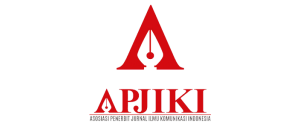Deadly Coal Social Campaign in Environmental Policy Advocacy for Indigenous Community of Kalimantan
DOI:
https://doi.org/10.30656/lontar.v11i2.7749Keywords:
Campaign, Coal, Deadlycoal, Indigenous CommunityAbstract
In the midst of the high production of coal to meet the energy needs of society, JATAM strives to carry out a social campaign for environmental advocacy in the indigenous communities of Kalimantan. The purpose of this article is to describe the management of JATAM's deadly coal campaign in advocating for the environmental rights of indigenous communities in Kalimantan due to coal mining activities. A qualitative research approach was chosen to uncover data to address these objectives. The data collection techniques employed were interviews and documentation through online media monitoring. The data analysis technique utilized three stages: data reduction, data presentation, and drawing conclusions. The results obtained indicate that the campaign aims to advocate for the rights of indigenous communities in Kalimantan to have a safe and healthy environment without mining contamination. The primary target audience includes indigenous communities and the government. In its implementation, JATAM engages in discussions and provides writing training for indigenous communities. Furthermore, JATAM collaborates with Greenpeace and other international NGOs to conduct on-the-ground lobbying of government policies through various actions. The targeted communities have shown a change in attitude and behavior, demonstrating acceptance and willingness to learn about the impacts of mining and their rights to life in their indigenous land.
References
Ahmed, Y., Chengming Zhang, P., & Kwan, J. (2021). Clinicians as community advocates: interplays of vaccines and society. University of Toronto Medical Journal, 98(3).
Almog-Bar, M., & Schmid, H. (2014). Advocacy activities of nonprofit human service organizations: A critical review. Nonprofit and Voluntary Sector Quarterly, 43(1), 11–35.
Annisa, I. S., & Mailani, E. (2023). Analisis Faktor Penyebab Kesulitan Siswa Dalam Pembelajaran Tematik Dengan Menggunakan Metode Miles Dan Huberman Di Kelas IV Sd Negeri 060800 Medan Area. Innovative: Journal Of Social Science Research, 3(2), 6460–6477.
Bang, G., & Lahn, B. (2020). From oil as welfare to oil as risk? Norwegian petroleum resource governance and climate policy. Climate Policy, 20(8), 997–1009.
Creswell, W. John & Creswell, J. D. (2018). Research Design: Qualitative, Quantitative and Mixed Methods Approaches. In Journal of Chemical Information and Modeling (Vol. 53, Issue 9).
Jaten, D., & Karanganyar Absori, K. (2007). Advokasi Masyarakat Dalam Penyelesaian Sengeketa Lingkungan Hidup. In WARTA (Vol. 10, Issue 1).
Marennu, S. A. (2019). Analisis Kebijakan Pemerintah Daerah Bidang Pertambangan di Kota Samarinda. Government: Jurnal Ilmu Pemerintahan, 21–32.
Nurislam, A. A., Hasid, Z., & Amalia, S. (2022). Dampak pertambangan batu bara bagi kehidupan sosial ekonomi masyarakat. Jurnal Ilmu Ekonomi Mulawarman (JIEM), 7(2).
Nwalie, M. I. (2019). Advocacy Coalition Framework and Policy Changes in a Thirdâ€World Country. Politics & Policy, 47(3), 545–568.
Prasetyo, T., Aeny, T. N., & Amelia, Y. (2021). Pemberdayaan Ekonomi dan Lingkungan Kelompok Masyarakat Adat Tiyuh Tanjung Seneng, Kota Bandar Lampung. Jurnal Nusantara Mengabdi, 1(1), 55–61.
Primasari, D. A. W., & Santosa, H. P. (2021). Pengaruh Terpaan Kampanye Diet Plastik dan Berita Kerusakan Lingkungan terhadap Perilaku Penggunaan Plastik. Interaksi Online, 10(1), 82–91.
Sari, A. K., Saputra, H., & Nainggolan, W. G. (2019). Pengaruh Praktik Perataan Laba Pada Perusahaan Tambang Yang Terdaftar Di Bursa Efek Indonesia. Jurnal Akuntansi Dan Bisnis: Jurnal Program Studi Akuntansi, 5(1), 60–70.
Seixas, B. V, Smith, N., & Mitton, C. (2018). The qualitative descriptive approach in international comparative studies: using online qualitative surveys. International Journal of Health Policy and Management, 7(9), 778.
Vakaliuk, T., Pilkevych, I., Fedorchuk, D., Osadchyi, V., Tokar, A., & Naumchak, O. (2022). Methodology of monitoring negative psychological influences in online media. Educational Technology Quarterly, 2022(2), 143–151.
Venus, A. (2018). Manajemen Kampanye: Panduan Teoretis dan Praktis dalam Mengefektifkan Kampanye Komunikasi (Revisi). Simbiosa Rekatama Media.
Ward, K. D., Mason, D. P., Park, G., & Fyall, R. (2023). Exploring nonprofit advocacy research methods and design: A systematic review of the literature. Nonprofit and Voluntary Sector Quarterly, 52(5), 1210–1231.
Yulianingrum, A. V., Nurfadillah, M., Riziq, S. M., & Novitadiningrum, A. (2023). Implikasi Kebijakan Pengelolaan Pertambangan Batubara Terhadap Eksistensi Masyarakat Hukum Adat Di Samarinda. AL-MANHAJ: Jurnal Hukum Dan Pranata Sosial Islam, 5(1), 915–924.
Zebua, W. D. A., Rahman, A., Utari, S. A., & Robbani, A. I. (2022). Persuasive Communication in the Covid 19 Campaign for Children. Jurnal Komunikasi, 14(1), 97. https://doi.org/10.24912/jk.v14i1.12513
Downloads
Published
Issue
Section
License
By submitting an article to the journal, the author(s) agree to transfer the published article's copyright to the journal, which will act as the publisher. This means the journal will have the right to publish the article in various forms, including reprints. The journal will maintain the publishing rights to the published articles.
In line with the license, authors and third parties (readers, researchers, and others) are allowed to share and adapt the material. In addition, the material must be given appropriate credit, provided with a link to the license, and indicated if changes were made. If authors remix, transform, or build upon the material, authors must distribute their contributions under the same license as the original.





